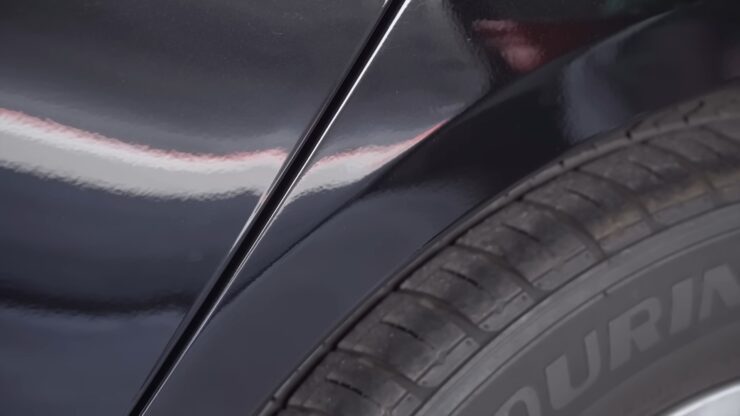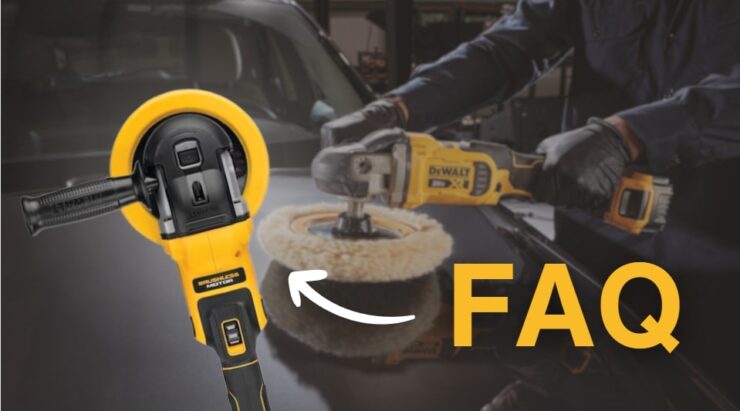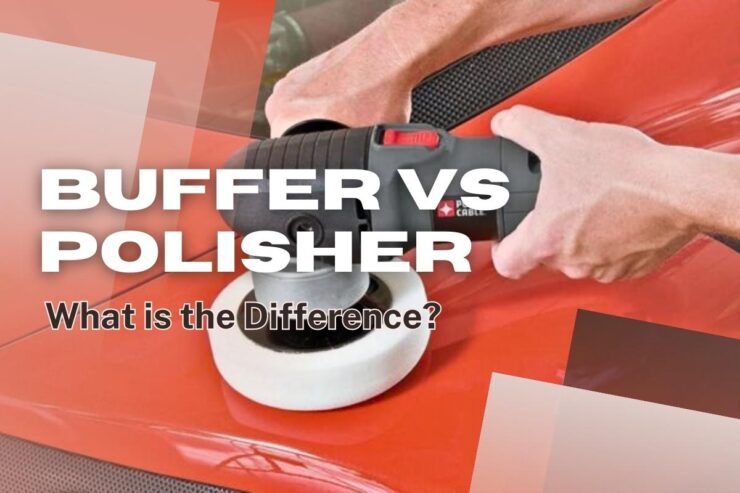Understanding the distinction between a vehicle buffer and a car polisher is essential if you want your automobile to look its best. Both machines have distinctive advantages that can make them ideal for various tasks.
We’ll examine the distinctions between these two devices in this section to assist you in selecting the best one for your needs.
As we delve into the nuances between a buffer and a polisher, it’s equally interesting to explore another closely related topic, the differences between car polish and wax, which might help you achieve that perfect shine on your vehicle.
The difference between car buffer and polisher
A vehicle buffer is a device that polishes and cleans your automobile’s paint using revolving discs. Buffers are ideal for removing blemishes from your paint, such as scratches and swirl marks.
A car polisher is a device that coats your car with wax or sealant using revolving pads. For a high-gloss finish and weather protection on your paint, polishers are ideal.
How does a buffer work?

A car buffer works by using rotating discs to clean and polish your paint. The discs are made of different materials, such as wool or foam, and they work to remove scratches, swirl marks, and other imperfections from your paint.
Benefits of using a buffer
Saving a lot of time is the main advantage of using a buffer. For instance, manually polishing a car can take hours, but utilizing a buffer can do the task quickly.
Using a buffer can also help you get better outcomes, which is another perk. It’s simple to miss spots or use too much pressure in one location when hand buffing your car, which can damage the paint. By using a buffer, you may get reliable answers by eliminating any element of guesswork from the equation.
removing damaged areas of your paint. Usually, items like bird droppings, tree sap, or road tar are the culprits behind defective areas. These stains have the potential to cause permanent harm if not cleared.
glossy surface. When detailing your car, adding a buffer can help you get the best-looking high-gloss finish possible. Unfortunately, it is extremely challenging, if not impossible, to achieve this kind of polish by hand.
Keep contaminants at bay. By hand buffing your car, you run the danger of introducing dust, debris, and skin oil to the paint. This risk is removed by using a buffer, which also keeps your paint looking its best.
Some buffers use heat-resistant motors to prevent overheating. By using a buffer, you may use the heat that is produced to shield your paint from things like tree sap and UV radiation.
Drawbacks of using a buffer
The fact that employing a buffer might be challenging to manage is one drawback. If you’re not careful, using the improper disc or exerting too much pressure might easily ruin your paint.
They’re not meant for newbies. It’s generally better to start with a polisher if you’re new to polishing your car. To use buffers correctly, you need additional expertise and understanding.
They might be pricey. It might not be worth the expense if you don’t intend to use one frequently.
How does a polisher work?

A car polisher works by using rotating pads to apply wax or sealant to your car. The pads are made of different materials, such as foam or wool, and they work to give your car a high-gloss finish. Polishers can also be used to protect your paint from the elements.
Benefits of using a polisher
The ability to give your car a high-gloss finish is the polisher’s main advantage. This kind of finish is extremely challenging, if not impossible, to achieve by hand.
Utilizing a polisher can also assist you in shielding your paint from the outdoors. Your car will have a barrier created by the wax or sealant that you apply that will keep out impurities like water and dirt.
Polishers can also be used to get rid of paint imperfections. Typically, road tar, tree sap, or bird droppings are to blame for imperfect areas. These stains have the potential to cause permanent harm if not cleared.
The final one is simple to utilize. Polishers don’t require any training and are rather simple to use.
Drawbacks of using a polisher
Utilizing a polisher has the drawback of temporarily making your car appear glossy, but that shine won’t last for very long. After two months have elapsed since the polisher was last used, the shine typically starts to diminish.
Another is that the outcomes are not long-lasting. Your automobile will eventually lose the wax or sealant that was applied, and you will need to reapply it to keep the high-gloss appearance.
Comparing a buffer and a polisher
Types and options
A machine called a buffer consists of a pad that rotates rapidly. You hold onto the handle that the pad is attached to as the machine works for you. Buffers come in a variety of sizes and forms, with circles being the most popular.
A machine called a polisher also has a revolving pad, but the pad is considerably smaller. Although it is also a handheld device, the polisher lacks a handle. Instead, you cling to the machine as it completes the task. Polishers are available in a variety of sizes and shapes, although they are most frequently oval in shape.
Abrasives
The outcomes depend on the kind of abrasive material utilized. A wool pad is the most typical kind of buffer abrasive. This pad’s purpose is to polish your paint to a high shine while removing flaws.
A foam pad is the most typical kind of abrasive for a polisher. The purpose of this type of pad is to apply wax or sealant to your car.
Size and shape
The size and shape of the machine will determine the areas you can reach. A buffer is typically larger and bulkier than a polisher, so it may be difficult to maneuver around tight spaces. A polisher is smaller and more compact, so it’s easier to maneuver around tight spaces.
Surface damage
Buffers are less harsh than polishers. It is as a result of the wool pad that buffers use, which is intended to erase paint flaws. Any protective layer on your paint, such as wax or sealant, will also be removed by the wool pad.
While a polisher makes use of a foam pad. The purpose of this type of pad is to apply wax or sealant to your car. The foam pad is far less harsh and won’t harm your paint’s protective covering.
FAQs

1. Can a buffer remove deep scratches from my car’s paint?
A buffer can remove some surface-level scratches, but deep scratches will require more extensive repair work. It’s best to consult with a professional to determine the best course of action.
2. How often should I use a buffer or polisher on my car?
It depends on the condition of your car’s paint and your personal preferences. It’s recommended to use a buffer or polisher a few times a year to maintain your car’s appearance and protect the paint.
3. Can I use a polisher to remove scratches from my car’s paint?
A polisher is designed to apply wax or sealant to your car’s paint, so it won’t be effective in removing scratches. You’ll need to use a buffer or seek professional repair services for scratch removal.
4. Do buffers and polishers require different types of pads for different tasks?
Yes, buffers and polishers require different types of pads for different tasks. Buffers typically use wool pads for polishing and foam pads for finishing, while polishers use foam pads for wax or sealant application.
5. Can I use a buffer or polisher on other surfaces besides car paint?
Yes, buffers and polishers can be used on other surfaces such as metal, glass, and plastic. However, it’s important to use the appropriate pad and abrasive for the surface to avoid damage.
6. Can using a buffer or polisher damage my car’s paint?
Yes, improper use of a buffer or polisher can damage your car’s paint. It’s important to follow instructions carefully and use the appropriate abrasive and pad for the task at hand.
7. Can I use a buffer or polisher on a new car with factory paint?
Yes, you can use a buffer or polisher on a new car with factory paint. However, it’s important to take care not to damage the paint and void any warranties. Consult with the manufacturer or a professional before use.
Conclusion
Both a buffer and a polisher have their benefits and drawbacks. It depends on what you’re looking to achieve and which one is the better choice. If you’re new to detailing your car, it’s probably best to start with a polisher.
But if you’re looking for consistent results, a buffer is the better choice. Ultimately, it comes down to your preferences and what you’re hoping to achieve.

